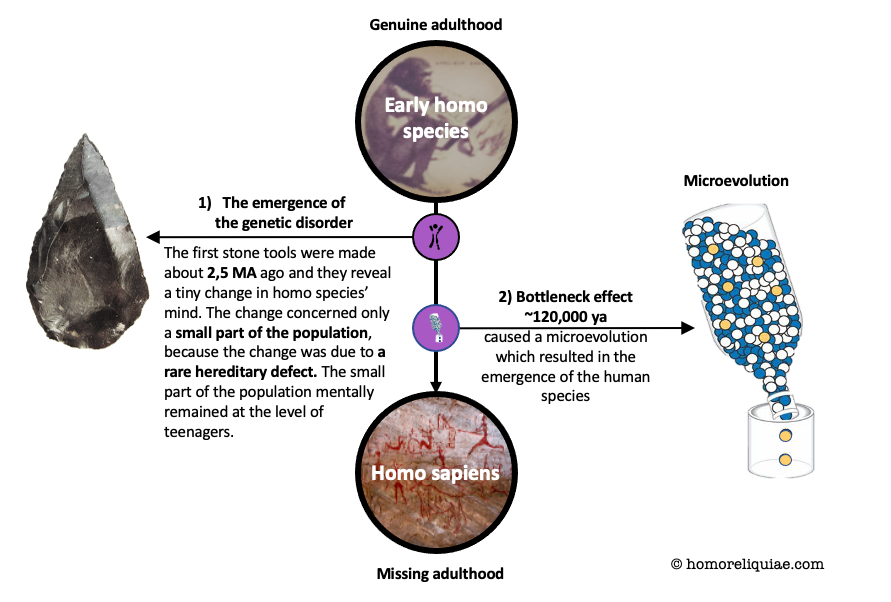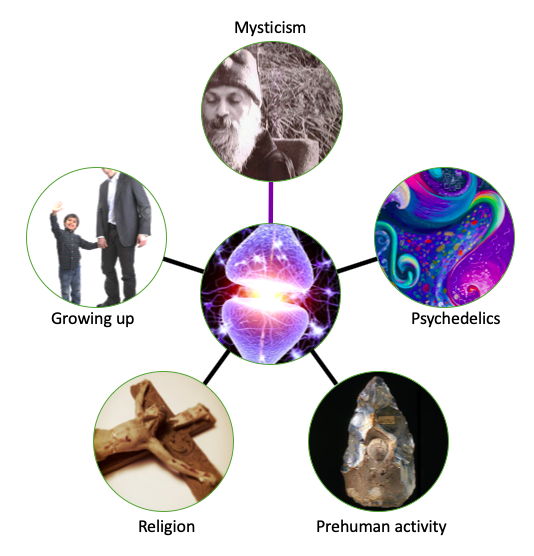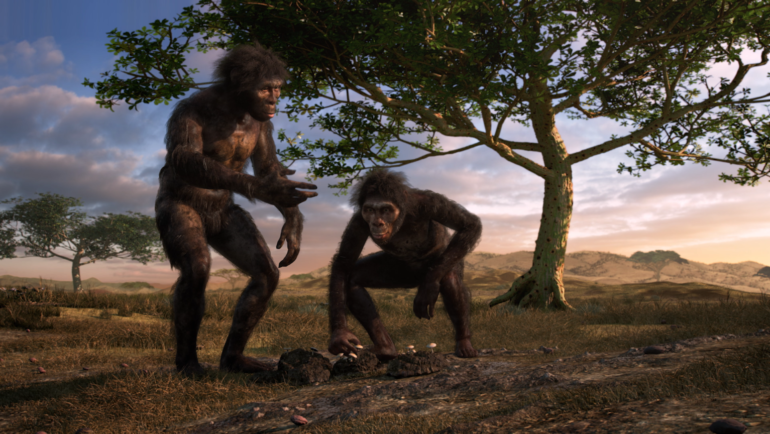What makes us human? Is it consciousness? Is it our ability to reach reality? And specifically better than other species? Do we have a purpose? Are we closer to the gods because of that? Because humans represent such a radical break with nature, the measures to find the answer are also extreme: brain imaging, DNA sequencing, magic mushrooms, Gaian mind theories…
However, it looks there is no need to go too far to look for an answer; we can also find it nearby. As Galileo Galilei said, “all truths are easy to understand once they are discovered; the point is to discover them“. Likewise, there is a chance that the big questions of human emergence, consciousness, religions, and mysticism are due to one single human trait: a mental growth failure.

We invariably turn a blind eye to the fact that we are mentally like teens, and we never have a feeling of being full-blown adults regardless of how long we live. We’ll act like that because we have learned to remain silent and take on the role of fake adulthood. Although we may try to rebel against it, we’ll accept the effectively ” anaesthetic” social contract, which leads only to the trivialisation of life. It’s a big mistake also because, in that way, we’ll never find out what makes us human and what human consciousness, reality, and gods are made of. There is a reason for our growth failure, but it has been kept secret.
The real adulthood unknown to us modern humans was commonplace to all pre-human species. But this was to change. The change was due to a failure of psychic growth inherited from some pre-human individuals to modern man over millions of years. Initial adulthood, however, still appears momentarily in connection with mystical and psychedelic experiences. Moreover, these experiences offer us also a clue as to how consciousness works. Unfortunately, civilisation obscures all the traces that would lead us to understand ourselves and our origins.
Circumstantial evidence
It’s time to bring into the open that real adulthood is a stage of psychic development resulting from a radical change in consciousness. But, alas, we have lost the opportunity for knowing it long ago. That is due to a failure we have inherited from the earlier human species. The loss is tricky to detect and only comes up in two ways. First, the so-called mystical experience tells us that we once had a mechanism that changed our consciousness; mystical experiences are remnants of this mechanism.
Second, psychedelics are capable of altering consciousness because they contain the same compounds as our nervous system. Psychedelics are not so much hallucinogens as they are highly selective psychic medication. Psychedelics can reset our teenage minds and restore the original adulthood of our species to normal. Psychedelics can also revive the early human mind and show that our mental growth disorder is a true and existing phenomenon. Psychedelics do not distort reality; on the contrary, they’ll fix it. Both mystical and psychedelic experiences have only a temporary effect, i.e. they don’t eliminate the problem, but they alleviate it. But most importantly, they reveal the problem.
Our genetic disorder
The entire mentality we call humanity may be due to a genetic defect. Many points support this argument. For example, phenomena created by mysticism, religions, and psychedelics are complicated to explain except through genetic defects. The human mental weakness started possibly as a recessive trait in the same way as colour blindness. In any case, it has now become a feature for which there is no alternative. We all have this mental growth disorder. And the reason is most likely that the original dominant trait disappeared when the human species emerged.
Therefore, the emergence of modern man and the radical spread of a gene defect probably mean the same thing. The process of emergence can be reconstructed, as shown further below. The gene defect can explain how human-like activity (such as making stone tools) could have existed even before we could speak of a species called homo sapiens. That is because “humanity” (i.e. defect) was already a feature of many pre-human species, although only on a small scale. The human peculiarity is not anatomical, not even the mental or its disorder. It is the fact that we all have the condition.
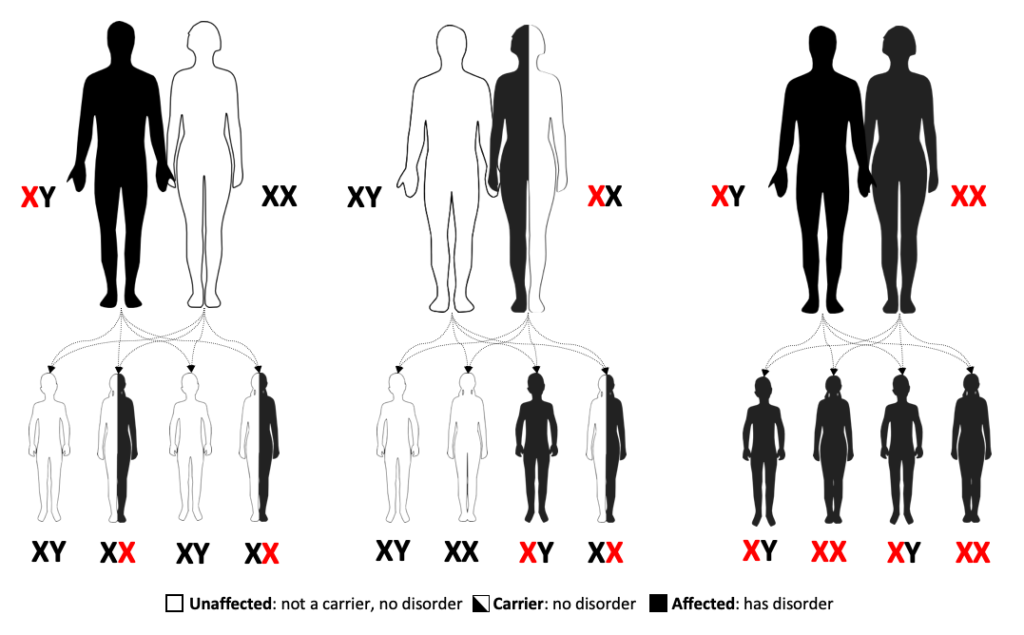
Some examples of how recessiveness could explain the slow emergence of human traits. The human mentality, or the permanently juvenile psyche, is seen in this hypothesis as a growth disorder caused by a recessive gene allele.
We can find the first signs of the genetic defect in the numerous stone tools, indicating not evolution but mental growth problems. As said, the growth disorder may well have been inherited in the same way as the rare colour blindness. Human colour blindness is caused by a gene defect and is recessively inherited. Recessiveness affects the incidence of a gene defect, meaning that the disorder requires appropriate parents to appear.
So if, as it looks, only 8% of men and 0.4% of women have red-green colour blindness, the impact on our society is not very significant. Accordingly, if 8/0.4% of men/women in pre-human populations were affected by mental adolescence or permanent consciousness, the percentages could well be consistent not only with the relatively small number of occurrences of stone tools but also with their minor effects. But this only applies until the emergence of modern humans. Then the number of stone tools exploded.
The fatal bottleneck and human emergence
The radical spread of stone tools suggests that something significant must have happened to the ratio of gene alleles, especially in one particular Heidelberg population in Africa: very likely, the recessive gene allele overthrew the population’s dominant one. There is only one explanation for this: genetic drift caused by a bottleneck effect. Only the genetic drift could have affected the occurrence of gene alleles. It is highly possible that due to some cataclysm, the population lost typically developing members but saved infected individuals.
So what could have caused the bottleneck? There is such an event to be found. In all probability, it’s the recent ice age. The emergence of modern humans more than 120,000 years ago from amongst the Heidelberg people was very likely the result of glaciation in the northern hemisphere that, in turn, caused a long and fatal drought which led to a population bottleneck. The genetic bottleneck in humans has usually been associated with the eruption of the Toba volcano 74,000 years ago. Still, it was probably of greater significance already 50,000 years earlier during the ice age. It caused a proliferation of growth disorder in the population. Eventually, this led to the emergence of modern man.
In this hypothesis, there are two significant stages in human emergence: 1) a genetic defect that appeared in early human populations for millions of years and was manifested in stone tools, clothing, using fire, and migrating out of Africa; 2) a bottleneck phenomenon in Africa, that caused the extinction of the normal and healthy Heidelbergs: they died but the defective ones survived. Thus, we are the offspring of the defective Heidelbergs. Both stages were necessary for human emergence.
The lost knowledge of human adulthood
People often talk about ancient lost or secret knowledge. I can think of only one secret in mysticism and religions, and it is related to lost human adulthood. And, likely, the ability has never disappeared, nor is it so secretive, occult or esoteric that anyone other than insiders could understand it. It is just hidden, mainly because if a person, even an adult, is considered a child, they always need a parent to guide and support them. Hiding the primal adult nature of man drives the business of people who want to control others.” The secret knowledge” contains ways to deal with the problems of human spiritual growth. It seems that it can only live in indigenous, nomadic and rural cultures; elsewhere, it becomes a mystery, a religion, and the secrets of the initiates. Initially, it might have even contained practical information on the problems of human adulthood. However, when the high culture obliterated the issues, old wisdom was no longer easy to understand and turned into myths like the story of Adam and Eve.
“Original sin” refers to a hereditary fault in genetics
The biblical story of the Fall of man echoes the earlier Mesopotamian myth of a king, as a primordial man, who is placed in a divine garden to guard the Tree of life. What is the Tree of life? Is the myth still possible to understand? Despite all the doubts, the tale fits miraculously well as an early explanation for the human psyche’s mental growth problem and genetic defect. Let’s take a look!
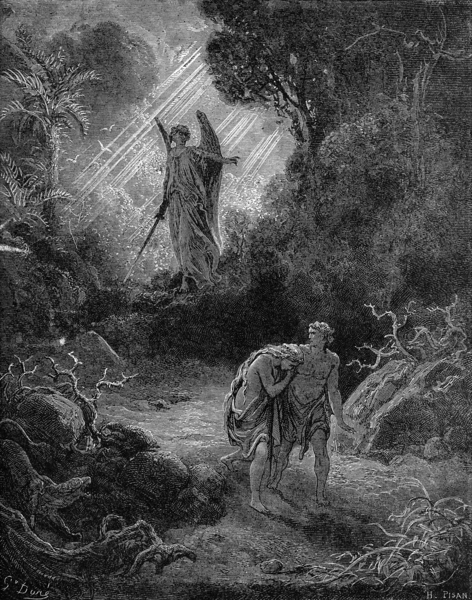
Paradise lost | It is difficult for us to see what is most evident in it: adulthood and the problems of growing up. The tree signifies cognition, and the serpent can be seen as a symbol of something we can now define as a mental defect or disorder. The forbidden fruit is human consciousness (and its components of volition, cognition and memory). Shame is just one of the mechanisms to protect growth. Paradise means nature from an adult perspective.
The thing that makes this interesting upon the cultural interpretation of the story is how it describes four critical elements of human burden: sexuality, shame, guilt and knowledge. Interestingly, explaining these by connecting them unlocks the human essence far better than any Western biblical study. The story seems to be a very concise description of human mental adolescence and its causes from this perspective. It gives facts the later civilisation wanted to ignore.
First, the tree of good and evil knowledge implies the existence of morality. And morality is part of cognition, neither of which was part of the adult psyche. For us, morality means the ability to distinguish good from evil. In Paradise, morality suggested debility, or vice, because morality equals condemnation. Human values of moral and immoral are inverted compared to those of Paradise or nature. That also applies to the “sins of the flesh”. Being ashamed of their natural sexuality, Adam and Eve condemn something created by God. The flesh was not sinful in Eden, but the fact that man considered it such. So we made nudity (nature) a moral issue.
It’s impressive how the serpent refers to something that could be seen as a genetic defect of all homo species mental development, the human mental growth disorder. The snake means poison to the human mind. Influenced by the Mesopotamian cultures, the serpent symbolises cunning, the skill of survival, and rebirth. Its “wisdom” is practical and strategic, not pure and deep understanding. It’s a survivor, just like a human. In that sense, it’s not the creation story but the story of the tree of good and evil knowledge that reconstructs the emergence of modern humans! That describes the moment when man factually emerges.
The story is highly ingenious also because, according to it, after eating the forbidden fruit, humans should have died (out), but, with the help of the serpent, they had been given “eternal” life. It is worth noting that from the standpoint of human evolution, this happened! Although man remained mortal, the human species was saved from extinction since we had escaped natural selection. So, this is more than just an allegory.
In my hypothesis, the roots of problems in people’s psychic growth, mysticism, psychedelics, early human tool making, and religions lie in neurochemical activity and its errors. However, the genetic defect is hard to detect as nothing happens. We need to know that something should happen.
It seems that civilisations are not paradises of wisdom. Instead, they always have something distorted, and they are disposed to rely on human inferiority. It is a big paradox that mystical experiences are despised in our civilisation. They are probably the only way to understand our true nature, growth disorder, and lost mental landscape. The lost feature has become a taboo and a myth. If only we overcome our prejudices and biases towards irrational phenomena, our spirituality, religiosity and mythical beliefs would have a lot to say about our ancient human nature.



